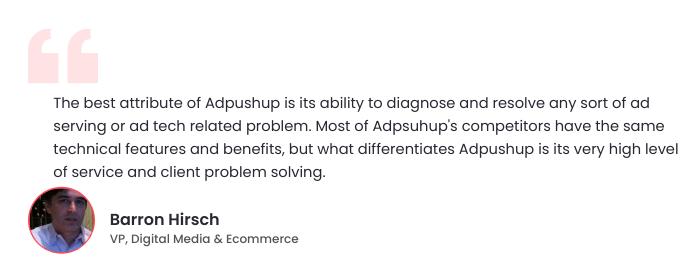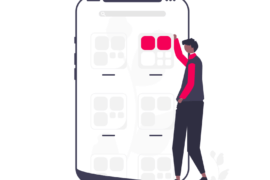Here is the complete overview of what is SKAdNetwork and what does it mean for app publishers.
The world of advertising is changing at a rapid scale, particularly for Apple device owners. With Apple’s impending crackdown on app tracking, tracking users at scale will become increasingly difficult.
As a result, the SKADNetwork is emerging as a potentially valuable alternative for advertisers in the iOS ecosystem.
Ad execs are now scrambling to understand what the SKADNetwork is and how it works, as it could significantly impact their campaigns.
Essentially, the SKADNetwork is a privacy-focused zone that allows advertisers to track specific metrics related to their campaigns while also respecting user privacy.
As the deadline for Apple’s crackdown approaches, it will be necessary for advertisers to pay attention to how SKADNetwork evolves and how they can use it effectively to reach their target audience.
In this blog, we have provided you with an overview of SKAdNetwork so that you can be more equipped than ever as an advertiser.
What is SKAdNetwork?
SKAdNetwork is an Apple framework that helps advertisers track and validate their app installations. It allows advertising networks to identify which campaigns are driving app installs and attribute those installs to specific ads. It is essential because it enables advertisers to measure the effectiveness of their campaigns and optimize their ad spend accordingly.
The framework involves three key participants:
- The ad network.
- The publisher or source app that displays the ads.
- The advertiser app that appears in the ads.
The ad network signs the ads and receives notifications when an install or postback occurs. The publisher app displays the ads provided by the ad network, and the advertiser app is the app that users will ultimately install on their devices.
One of the critical benefits of SKAdNetwork is that it maintains user privacy. Advertisers can still measure the effectiveness of their campaigns without compromising the personal data of the users who install their apps.
Overall, SKAdNetwork is an essential tool for advertisers tracking app installations and measuring their advertising ROI.
How to Setup and Register for SKAdNetwork?
The process of setting up a SKAdNetwork ID with Apple involves a few steps:
- Register with your ad network and get a unique ID for it.
- Generate a cryptographic key pair and then share that key with Apple, which is used for verifying signatures.
- Provide a URL to receive SKAdNetwork install validation request.
This process is designed to ensure that the SKAdNetwork framework can accurately attribute app installs to the correct ad network while maintaining user privacy and security.
By creating a secure and standardized process for registering and verifying ad networks, Apple is working to improve transparency and trust within the mobile advertising ecosystem.
What are the Limitations of SKAdNetwork?
There are some inherent limitations of SKADNetwork, a framework for measuring the effectiveness of mobile advertising campaigns.
These limitations are not accidental but instead are carefully designed into the framework. For example, the data collected by SKADNetwork is aggregated and not directly accessible, as it is owned and reported by the advertising networks.
This lack of direct access to data can make it difficult to optimize campaigns in real-time and also limits the amount of detail available on how well ads have performed.
Furthermore, since the ad networks are essentially marking their own homework, there is the possibility of data manipulation by unscrupulous networks, which could call into question the accuracy of the data provided by SKADNetwork.

What Would Be the Future Approach of Advertisers?
Advertisers who run mobile app campaigns on iOS devices are facing new challenges due to changes in Apple’s framework. These changes require them to establish new processes so as to ensure that they are gathering and processing SKADNetwork data accurately and efficiently. It includes validating the data and rethinking their entire approach to collecting and verifying data from different ad networks throughout the ad tech supply chain.
In essence, this means that advertisers must adapt their strategies to stay in sync with Apple’s updated framework, which can be a complex and time-consuming process. Nonetheless, by doing so, they can ensure that their app campaigns on mobile iOS devices remain effective and relevant, providing valuable insights into user behavior and engagement.
How Can Publishers Adapt?
There is a possibility that SKADNetwork could become the primary target of media buyers once mobile identifiers become obsolete. If this were to happen, publishers who have not prepared for the shift towards SKADNetwork could potentially lose out on media revenue.
Demand side platforms have already begun to demand that app publishers keep up to date with their list of SKADNetwork IDs, and publishers must do the same to avoid any legal infringements, as Apple has stated that they will hold publishers accountable for any violations.
Therefore, it is crucial for publishers to prepare for the potential dominance of SKADNetwork in the media buying landscape to avoid missing out on revenue and facing legal consequences.
Is There Any Other Way to Avoid This Hassle?
Apple is taking a firm stance when it comes to ad executives who want to target users on their platform. They are limiting attempts to identify users’ identities, which leaves ad executives with few options for targeting their ads effectively. While some app monetization firms are exploring contextual targeting as an alternative, it remains to be seen whether it can match the effectiveness of identity-powered targeting on mobile.
Other app developers may resort to using emails as an alternative, but it’s challenging to capture a large enough number of them.
Despite the struggle, there are a growing number of ad executives who are looking into aggregated attribution strategies that combine deterministic and probabilistic methods with differential privacy ideas. SKADNetwork is expected to play a crucial role in improving the accuracy of attribution, but it’s not necessarily a workaround – more like a circuitous concession.
In short, Apple’s limitations on identifying user identities are posing challenges for ad executives, who are exploring various options for targeting ads effectively on the platform. While some alternatives exist, they may not be as effective as traditional methods, and the industry is still figuring out how to navigate these changes.
What’s Next In SKAdnetwork?
Some advertising executives have been exploring how the SKADNetwork framework works and have come to the conclusion that it provides an unfair advantage to Apple’s own ad network over its competitors. It is because marketers are able to access more detailed data about their campaigns when using Apple’s network compared to other networks.
This perceived advantage is causing concern among industry insiders, who worry that Apple’s approach may be seen as unfair and could potentially lead to regulatory issues.
Some executives are holding out hope that Apple will make changes before its planned crackdown on track, as failing to do so could harm the company’s reputation and standing in the eyes of regulators.

Shubham is a digital marketer with rich experience working in the advertisement technology industry. He has vast experience in the programmatic industry, driving business strategy and scaling functions including but not limited to growth and marketing, Operations, process optimization, and Sales.








